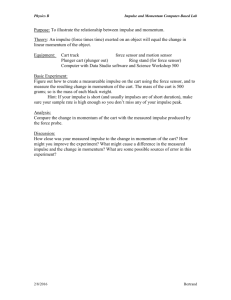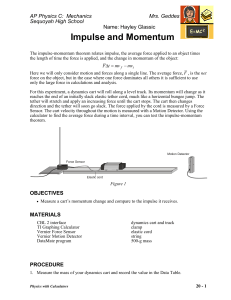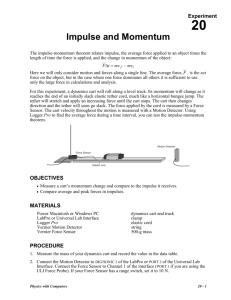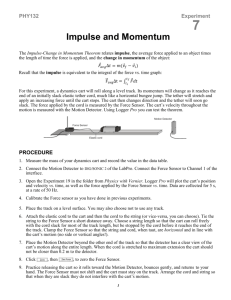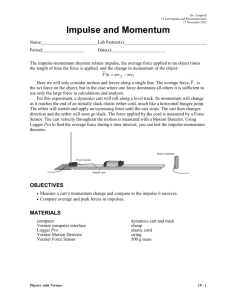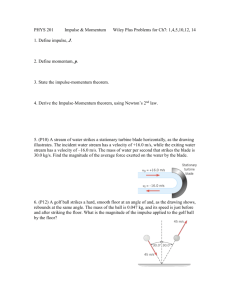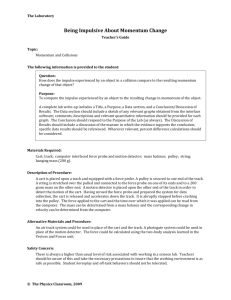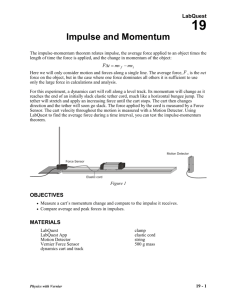Impulse and Momentum Lab Experiment: Physics
advertisement
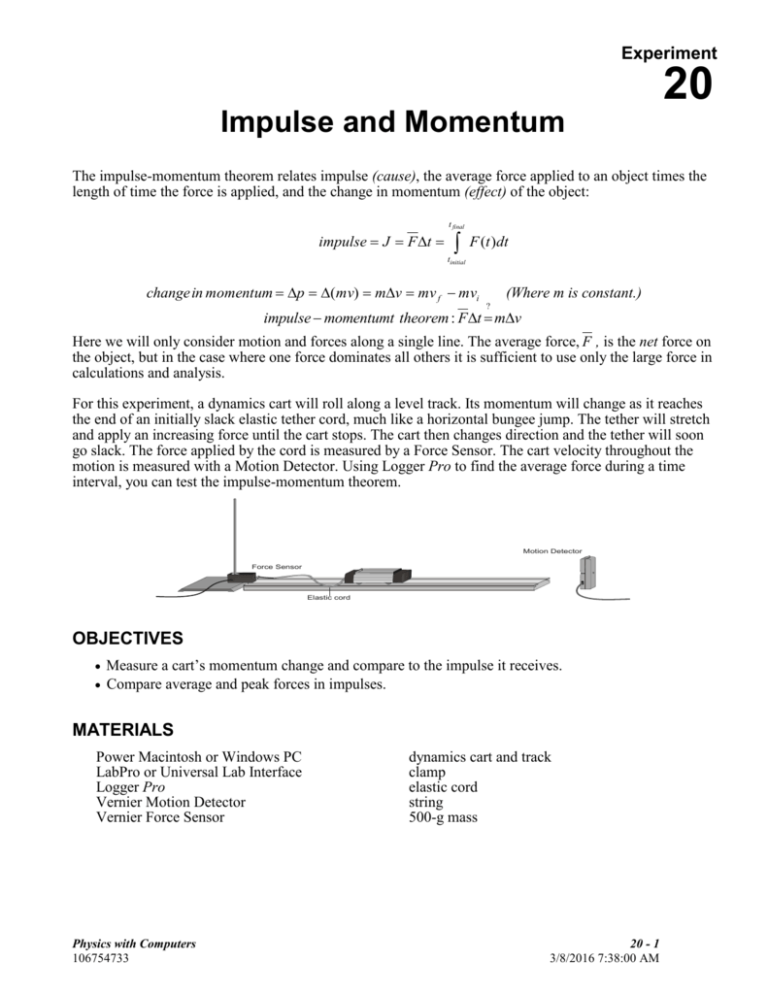
Experiment 20 Impulse and Momentum The impulse-momentum theorem relates impulse (cause), the average force applied to an object times the length of time the force is applied, and the change in momentum (effect) of the object: t final impulse J F t F (t )dt tinitial change in momentum p (mv) mv mv f mvi (Where m is constant.) ? impulse momentumt theorem : Ft mv Here we will only consider motion and forces along a single line. The average force, F , is the net force on the object, but in the case where one force dominates all others it is sufficient to use only the large force in calculations and analysis. For this experiment, a dynamics cart will roll along a level track. Its momentum will change as it reaches the end of an initially slack elastic tether cord, much like a horizontal bungee jump. The tether will stretch and apply an increasing force until the cart stops. The cart then changes direction and the tether will soon go slack. The force applied by the cord is measured by a Force Sensor. The cart velocity throughout the motion is measured with a Motion Detector. Using Logger Pro to find the average force during a time interval, you can test the impulse-momentum theorem. Motion Detector Force Sensor Elastic cord OBJECTIVES Measure a cart’s momentum change and compare to the impulse it receives. Compare average and peak forces in impulses. MATERIALS Power Macintosh or Windows PC LabPro or Universal Lab Interface Logger Pro Vernier Motion Detector Vernier Force Sensor Physics with Computers 106754733 dynamics cart and track clamp elastic cord string 500-g mass 20 - 1 3/8/2016 7:38:00 AM Experiment 20 PRELIMINARY READING AND QUESTIONS Read/Do/Explore the following: The Physics Classroom, Impulse: U4L1b, including CYU questions. All parts of this lab. 1. In a car collision, the driver’s body must change speed from a high value to zero. This is true whether or not an airbag is used, so why use an airbag? How does it reduce injuries? 2. You want to close an open door by throwing either a 400-g lump of clay or a 400-g rubber ball toward it. You can throw either object with the same speed, but they are different in that the rubber ball bounces off the door while the clay just sticks to the door. Which projectile will apply the larger impulse to the door and be more likely to close it? Explain. 3. Sketch plots of position vs. time, velocity vs. time, force vs. time, and force vs. position for the time period between release and capture of the cart. The time axes for the first three should be aligned vertically. 4. Open the sample data file listed below. The cart has a mass of 0.500 kg. Name the top data row of each data and calculation table “Sample” and complete using Run 1sample data. 5. How many trials are to be done? PROCEDURE 1. Measure the weight of your dynamics cart and record the value in the data table. 2. Connect the Motion Detector to DIG/SONIC 2 of the LabPro. Connect the Force Sensor to Channel 1 of the interface. If your Force Sensor has a range switch, set it to 10 N. 3. Open the appropriate Exp 20 file from the course outline web page. LoggerPro will plot the cart’s position and velocity vs. time, as well as the force applied by the Force Sensor vs. time. Data are collected for 5 s, at a rate of 50 Hz. Note the sample data. 4. Skip this step. If you ask Mr. Alsin why, he will deduct 6.02 x 1023 points from your grade. 5. Place the track on a level surface. Level the track using a spirit level. 6. Attach the elastic cord to the cart and then the cord to the string. Tie the string to the Force Sensor a short distance away. Choose a string length so that the cart can roll freely with the cord slack for most of the track length, but be stopped by the cord before it reaches the end of the track. Clamp the Force Sensor so that the string and cord, when taut, are horizontal and in line with the cart’s motion. 7. Place the Motion Detector beyond the other end of the track so that the detector has a clear view of the cart’s motion along the entire track length. When the cord is stretched to maximum extension the cart should not be closer than 0.4 m to the detector. 8. Click , then , to zero the Force Sensor. Do not zero the MD. 9. Practice releasing the cart so it rolls toward the Motion Detector, bounces gently, and returns to your hand. The Force Sensor must not shift and the cart must stay on the track. Arrange the cord and string so that when they are slack they do not interfere with the cart motion. You may need to guide the string by hand, but be sure that you do not apply any force to the cart or Force Sensor. Keep your hands away from between the cart and the Motion Detector. 10. Click to take data; roll the cart and confirm that the Motion Detector detects the cart throughout its travel. Inspect the force data. If the peak is flattened, then the applied force is too large. Roll the cart with a lower initial speed. If the velocity graph has a flat area when it crosses the x-axis, the Motion Detector was too close and the run should be repeated. 20 - 2 Physics with Computers Impulse and Momentum 11. Once you have made a run with good distance, velocity, and force graphs, analyze your data. To test the impulse-momentum theorem, you need the velocity before and after the impulse. Choose a time interval just before the bounce when the speed was approximately constant, and drag the mouse pointer across the interval. Click the Statistics button, , and read the average velocity. Record the value in your data table. In the same manner, determine the average velocity just after the bounce and record the value in your data table. Remove the floating boxes by clicking the gray close box in their upper right corners. 12. There are two ways to calculate the impulse. Use both methods. Method 1 [Better method.]: Calculus tells us that the expression for the impulse is equivalent to the integral [area under the curve] of the force vs. time graph, or t final F (t )dt F t tinitial On the force vs. time graph, drag across the impulse, capturing the entire period when the force was non-zero. Find the area under the force vs. time graph by clicking the integral button, . Record the value of the integral in the impulse column of your data table. Method 2: On the force vs. time graph, drag across the impulse, capturing the entire period (but no extra) when the force was non-zero. Find the average value of the force by clicking the Statistics button, . The interval t will be shown on the graph. Record the values in your data table. Ft Valid if F varies linearly. 13. Add a cart mass and perform a second trial by repeating Steps 10 – 12. Record the information in your data table. 14. Change the elastic material attached to the cart. Use a new material, different elastic band, or attach two elastic bands in parallel. 15. Repeat Steps 10 – 13, record the information in your data table. DATA & CALCULATION TABLES Cart Block Weight (N) Mass (kg) Trial Final Velocity, vf (m/s) Average Force, F (N) Initial Velocity, vi (m/s) Duration of Impulse, t (s) Value Change in Velocity, v (m/s) Change in momentum (kgm /s) or (Ns) Impulse (Ns) Method 1 Method 2 (Integral) (FΔt) % Difference between value and mean. Δp Impulse (Method 1) Impulse (Method 2) Mean of three values Physics with Computers 20 - 3 Experiment 20 ANALYSIS Impulse is a measure of what was done to the object: the rubber band applied a force over a time. Change in momentum is a measure of what resulted: the velocity of the cart changed. Include in your lab writeup the relevant plots and data analysis boxes for trial 1. 1. Calculate the change in velocities and record in the data table. From the mass of the cart and change in velocity, determine the change in momentum as a result of the impulse. Make this calculation for each trial and enter the values in the second data table. 2. For the average force (non-calculus) method, determine the impulse for each trial from the average force and time interval values. Record these values in your data table. 3. If the impulse-momentum theorem is correct, the change in momentum will equal the impulse for each trial. Experimental measurement errors, along with friction and shifting of the track or Force Sensor, will keep the two from being exactly the same. One way to compare two or moe values that are supposed to be equal is to find their percentage difference. Divide the difference between the value and the mean by the mean, then multiply by 100%. How close are your values, percentage-wise? Do your data support the impulse-momentum theorem? 4. Look at the shape of the last force vs. time graph. Is the peak value of the force significantly different from the average force? Is there a way you could deliver the same impulse with a much smaller force? 5. Revisit your answers to the Preliminary Questions in light of your work with the impulse-momentum theorem. 6. When you use different elastic materials, what changes occurred in the shapes of the graphs? Is there a correlation between the type of material and the shape? 7. When you used a stiffer or tighter elastic material, what effect did this have on the duration of the impulse? What affect did this have on the maximum size of the force? Can you develop a general rule from these observations? 8. Quiz Heads Up: Use the plots in the lab to determine Δp, W, ΔK, J, and m. FOLLOW UP 1. Read The Physics Classroom, Real World Applications (U4L1c.html) of Impulse. Read §7.3 in your text. Work the example problem. 2. Know Why: Questions, Ch. 7: 6, 7, 9, 12. Use physics concepts and proper sentence mechanics. 3. Know How. Problems, Ch. 7: 15, 18, 20, 21, 75. Show all work, legibly and logically, for problems. Hint on 75: Use your TI to graph and calculate the area under the curve. EXTENSIONS 1. A bouncing ball can be considered to be an elastic material. Using a motion detector, determine the coefficient of restitution (chapter 7, problem 37) for a bouncing ball. The coefficient should be calculated using the average of a minimum of 4 successive bounces. For each bounce, calculate the coefficient of restitution, the impulse given to the ball, the ratio of final momentum to initial momentum, and the ratio of final to initial kinetic energy. Draw conclusions about a bouncing ball in terms of these concepts. 2. Use a force sensor and motion detector with a spring cart and track to determine the impulse provided by the spring plunger of the cart. You should calculate this impulse using two separate methods [equations, data]. This does not mean two separate trials using the same equation(s). 20 - 4 Physics with Computers
